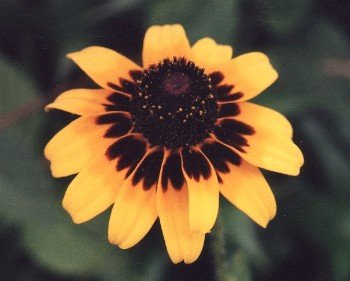Black-Eyed Susan
by Valerie (July 29, 2001)

Common all over much of the U.S., black-eyed Susan (Rudbeckia hirta) is one of the most easily recognized wildflowers we have. Originally from the eastern states, it is now endemic in our area, sometimes forming large patches. Because the center of the flower isn't really black, but a dark brown, I've also heard this flower called brown-eyed Susan. Being an annual, its presence in our gardens each year is not guaranteed, but the seeds germinate fairly easily and the plants will grow in sunny locations. Like other members of the sunflower family, black-eyed Susan has a blossom made up of a group of two different kinds of flowers. The center contains disk flowers and the large outer "petals" are ray flowers. The blossoms last a long time because the disk flowers open in sequence, from edge to center, over a period of several days. When a flower head is young, the disk blossoms are closed and look very silky. As they open, the yellow pollen is evident and the center of the flower looks rough. The ray flowers vary from being all yellow to having a large brown spot near the center. Each plant is consistent, and usually a whole patch will display the same amount of brown. In our area, there are very few solid yellow blossoms; almost all seem to have the brown spots. The size of these flowers varies considerably, depending on growing conditions. In shady, dry areas, there may be only one blossom per plant. We sometimes have a plant grow only a few inches tall, produce a tiny flower less than an inch across, then die. More commonly, the plants produce multiple blossoms, especially if given water. Eventually the heat kills off the entire plant, leaving the dry seed pods to wait for the following spring. |